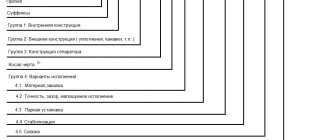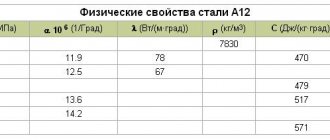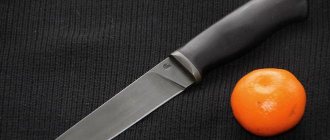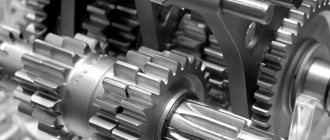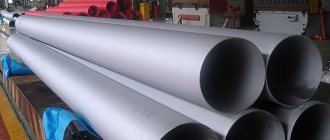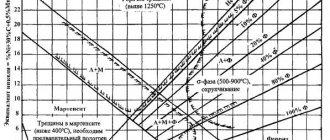Types of steels and features of their markings
Various areas of application of steel require that it have strictly defined properties - physical, chemical. In one case, the highest possible wear resistance is required, in others, increased resistance to corrosion, in others, attention is paid to magnetic properties.
There are many types. The bulk of the smelted metal goes into the production of structural steel, which includes the following types:
- Construction Low alloy steel with good weldability. The main purpose is the production of building structures.
- Spring. They have high elasticity, fatigue strength, and fracture resistance. Used for the production of springs and leaf springs.
- Bearing. The main criterion is high wear resistance, strength, low fluidity. It is used for the production of units and components of bearings for various purposes.
- Corrosion resistant (stainless). High-alloy steel with increased resistance to aggressive substances.
- Heat resistant. It is distinguished by its ability to work for a long time under load at elevated temperatures. Area of application: engine parts, including gas turbine engines.
- Instrumental. Used for the production of metal and woodworking and measuring instruments.
- Fast cutting. For the manufacture of tools for metalworking equipment.
- Cementable. It is used in the manufacture of parts and assemblies operating under high dynamic loads under conditions of surface wear.
Steel classification
When deciphering the designations, it is necessary to take into account that each of the types corresponds to a strictly defined letter in the marking.
Materials Science
10
- structural high-quality carbon steel. The figure indicates the carbon content in hundredths of a percent. Steel contains 0.10% carbon.
Used in mechanical engineering for parts with high ductility. May be subject to cementation; St5
The letters “St” in the steel grade mean “Ordinary quality steel”; the number after St is the conventional grade number depending on the chemical composition of the steel (steel No. 5). Application: parts of riveted structures, bolts, nuts, handles, rods, bushings and other parts operating in the temperature range from 0 to +425С.
14ХГ2AF
— low-alloy structural steel. The number before the letters indicates the carbon content in hundredths of a percent (0.14%). The letter “X” indicates chromium alloying in an amount of 1.5 (there is no number after the letter). The letter “G” indicates doping with Manganese in an amount of 2% (the number 2 follows the letter). The letter “A” in the middle of the mark indicates doping with nitrogen in an amount of 1%. The letter “F” indicates doping with vanadium in an amount of 1%. Application: load-bearing elements of welded structures operating under variable loads.
ШХ15
- structural bearing steel. The letters “ШХ” indicate that the steel is ball bearing. The figure indicates the carbon content in tenths of a percent (0.15% Chromium). Carbon content 1%. Application: balls with a diameter of up to 150 mm, rollers with a diameter of up to 23 mm, bearing rings with a wall thickness of up to 14 mm, plunger bushings, plungers, discharge valves, spray bodies, pusher rollers and other parts that require high hardness, wear resistance and contact strength .
30G2
- Structural alloy steel (manganese). The number before the letters indicates the carbon content in hundredths of a percent (0.30%). The letter “G” indicates doping with manganese in the amount of 2 (the number 2 is after the letter). Application: Crankshafts, axle shafts, axles, clutch levers, gear shift forks, flanges
20Х2Н4М
— structural (machine-building) alloy steel. The number before the letters indicates the carbon content in hundredths of a percent (0.20%). The letter “X” indicates alloying with chromium in an amount of 2% (after the letter there is a number 2). The letter “H” indicates doping with Nickel in an amount of 4% (the number 4 appears after the letter). The letter “M” indicates doping with Molybdenum in an amount of 1%. Application: gears, pinion shafts, pins and other cemented, critical, highly loaded parts that are subject to high strength requirements.
70С3
Structural spring steel. The number before the letters indicates the carbon content in hundredths of a percent (0.70%). The letter “C” indicates doping with Silicon in an amount of 3% (after the letter there is the number 3). Application: heavily loaded springs for critical purposes.
38Х2МУА – alloy structural steel. The number before the letters indicates the carbon content in hundredths of a percent (0.38%). The letter “X” indicates alloying with chromium in an amount of 2% (after the letter there is a number 2). The letter “M” indicates doping with Molybdenum in an amount of 1%. The letter “Yu” indicates alloying with Aluminum in an amount of 1%. The letter “A” at the end of the steel grade indicates that the steel is high quality (contains less harmful impurities - sulfur and phosphorus). Application: nitrided parts: gears, rollers, pins, bushings, etc., operating at temperatures up to 450 °C. 15Х25Т
corrosion-resistant, heat-resistant steel (ferritic class).
The number before the letters indicates the carbon content in hundredths of a percent (0.15%). The letter “X” indicates chromium alloying in an amount of 25% (after the letter there is the number 25). The letter “T” indicates titanium doping in an amount of 1%. Application: for welded structures not exposed to shock loads at operating temperatures from -20 °C to 1100 °C. Pipes for heat exchange equipment operating in aggressive environments. Equipment, parts, thermocouple covers, spark plug electrodes, heat exchangers. 03Х18Н11
corrosion-resistant steel (austenitic class).
The number before the letters indicates the carbon content in hundredths of a percent (0.03%). The letter “X” indicates chromium alloying in an amount of 18% (after the letter there is the number 18). The letter “H” indicates doping with Nickel in an amount of 11%. Application: products operating in nitric acid environments at elevated temperatures KCh60-2
- Malleable cast iron of pearlitic class.
The letters “KCH” stand for Malleable cast iron. The first number after the letters indicates the tensile strength divided by 10 (B = 600 MPa). The second number indicates elongation (=2%). Application: for the manufacture of machine parts requiring high strength and ductility. 9ХС
- alloy tool steel.
The number before the letters in tool steel grades indicates the carbon content in tenths of a percent (0.9%). The letter “X” indicates chromium alloying in an amount of 1% (there is no number after the letter). The letter “C” indicates doping with Silicon in an amount of 1%. Application: drills, reamers, taps, dies, combs, cutters, machine dies, stamps for cold work. Critical parts, the material of which must have increased wear resistance, fatigue strength during bending, torsion, contact loading, as well as elastic properties. AChS4
antifriction gray cast iron with lamellar graphite.
The letter “A” indicates that cast iron is anti-friction. The letters “ChS” are gray cast iron. Application: for work in conjunction with a heat-treated (hardened or normalized) shaft 3Х3М3Ф
- die tool steel.
The number before the letters in steel tool grades indicates the carbon content in tenths of a percent (0.3%). The letter “X” indicates chromium alloying in an amount of 3% (after the letter there is the number 3). The letter “M” indicates doping with Molybdenum in an amount of 3% (after the letter there is a number 3). The letter “F” indicates doping with vanadium in an amount of -1%. Application: hot deforming tools on crank presses and horizontal forging machines, subjected to intense cooling during operation (usually for small tools), injection molds for copper alloys. R12F3
- high-speed tool steel.
The letter “P” indicates that the steel is high-speed. The number after the letter “P” indicates the tungsten content (12%). The letter “F” indicates vanadium doping in an amount of 3% (number 3 after the letter). Application: for finishing tools when processing tough austenitic steel and materials with abrasive properties. Heat resistance 620 С. T16K6
- hard alloy. The letter “T” indicates the content of titanium carbide 16% (the number after the letter). The letter “K” indicates a Cobalt content of 6% (the number after the letter). The rest is tungsten carbide Application: Finish and semi-finish milling of carbon and low-alloy structural steels, steel castings, forgings.
AD31
- aluminum wrought alloy.
The letter “A” indicates that the alloy is aluminum based. The letter “D” denotes a wrought alloy. The number indicates the alloy number. Application: for the manufacture of parts of low strength and high corrosion resistance, operating in the range from -70 to 50 С. AK5M4
is an aluminum casting alloy.
The letter “A” indicates that the alloy is aluminum based. The letter “K” indicates silicon doping in an amount of 5% (the number after the letter). The letter “M” denotes alloying with Copper in the amount of 4% (the number after the letter). Application: for the production of ingots and shaped castings using various casting methods (sand molds, lost wax, die casting, injection molding) D16
is a wrought aluminum alloy.
The letter “D” stands for aluminum wrought alloy. Application: for power elements of aircraft structures, car bodies, pipes, etc.; for parts operating at temperatures up to 230С. LOMts70-1-1
- tin brass.
Letter “L” brass. The letter “O” indicates doping with Tin. ,,Mts” doping with Manganese. The numbers after the letters indicate the content of Copper, Tin and Manganese, respectively 70, 1 and 1% Application: for the manufacture of condenser tubes in marine shipbuilding. BrB2
- beryl bronze, processed by pressure.
Letters “Br” - bronze. The letter “B” indicates doping with beryllium (2%). Application: Springs, spring parts for critical purposes, wear-resistant parts of all types, non-sparking tools. MA5
is a wrought magnesium alloy. The letters “MA” indicate a wrought magnesium alloy. Application: for loaded parts; maximum operating temperature: 150°C - long-term, 200°C - short-term
BN
- a tin-based alloy (babbitt) containing 11% tin (lead base) and alloyed with nickel. Used as an antifriction material for plain bearings.
POSSu18-8
- tin-lead solder with antimony. The letter "P" is solder. The letter “O” is tin. The letter "C" contains lead. "Su" contains Antimony. The numbers indicate the element content in %. Tin 18%, Antimony 8%, the rest lead. Used for soldering brass, copper, steel, bronze.
PSr2
- silver solder. The letter “P” is solder. Letters ,, Ср” - silver. Silver content 2%. Application: Soldering copper and nickel with glass enamel and ceramics; Soldering and tinning of jewelry
Classification by chemical composition
The main alloying additives are metals. By varying the quantitative composition of additives and their mass fraction, a wide variety of steel grades are obtained. Pure iron itself has low technical properties. Low mechanical strength and high susceptibility to corrosion require the introduction of additional substances into the alloy composition, which are aimed at improving one of the qualities, or several at once.
Often, the improvement of some characteristics entails the deterioration of others. Thus, high-alloy stainless steels may have low mechanical strength, while high-quality carbon steels, along with high strength, receive weakened corrosion properties.
As mentioned above, one of the classifications of steel grades is its chemical composition. The main components of all steels without exception are iron and carbon, the content of which should not exceed 2.14%. Depending on the amount and proportions of additives, the iron content in the composition should be at least 50%.
Based on the amount of carbon contained, steels are classified into three groups:
- Low-carbon – carbon content less than 0.25%;
- Medium carbon – 0.25-0.6% carbon;
- High carbon, with a carbon content of more than 0.6%.
An increase in the percentage of carbon increases the hardness of the metal, but at the same time its strength decreases.
To improve performance, a certain amount of chemical elements is introduced into the alloy. Such steels are called alloyed. For alloy steels there is also a division into three groups:
- Low alloy, containing additives up to 2.5%;
- Medium alloyed, which contain from 2.5 to 10% alloying elements;
- Highly alloyed. The content of alloying impurities varies from 10 to 50%.
The marking of steels reflects the presence and percentage of alloying additives. When deciphered, each element is assigned a specific letter, next to which there is a number corresponding to its content as a percentage. The absence of numbers indicates that the additive is present in the alloy in an amount of less than 1-1.5%. The presence of carbon in the composition is not reflected, since it is included in all compositions, but its content is indicated at the very beginning of the labeling.
The marking can also indicate the purpose of the alloy. Since this classification also uses letter designations, the order of their arrangement is regulated - at the beginning, middle and end of the marking.
Steel classification
To understand the markings, you need to understand how steel alloys are classified according to their intended purpose. It is customary to determine properties according to several parameters:
- The chemical composition determines the strength indicators. Here the properties are determined by the compositional ratios between iron and carbon. Along the way, changes in characteristics depend on the presence of alloying elements or substances that impair performance.
- The structure changes depending on the production methods. Forged products are stronger, cast ones may form pores or other defects. When rolling through rollers, hardening is achieved and the desired shape is obtained.
- For proper use, certain brands are determined by their intended purpose. Such information is especially important for special-purpose steels. In them, even small changes in the chemical composition can significantly change the behavior under load or operation in an aggressive environment.
- The quality of steel ingots depends on the content of harmful components. Sulfur and phosphorus lead to cold brittleness and red brittleness, so metallurgists try to remove deteriorating ingredients from the alloy.
- Oxygen in steel products changes the structure. To remove it, deoxidizers are added to the molten mass; they form oxides and do not cause negative changes to the metal.
Classification of steels according to main indicators
Classification by structure
The structure is studied on special thin sections. They are examined under a microscope, having previously treated the polished surface with sulfuric acid. It is customary to define the following states:
- Hypoeutectoids are characterized by a high ferrite content. Low carbon content does not allow the metal to exhibit sufficient resistance under mechanical loads;
- eutectoid correspond to the best ratio between strength and plastic properties;
- hypereutectoid steels are used in the manufacture of tools. They are distinguished by high surface hardness, as well as resistance to loading;
- ledeburite contain carbides. The metal exhibits excessive fragility;
- Ferritic indicators correspond to the properties inherent in pure iron.
Ledeburite. Iron carbide inclusions are visible
To improve properties, normalization is carried out. It consists of relieving stress from parts that have had heat treatment associated with improved properties. Prolonged heating and holding at temperatures above 720...750 °C, and subsequent cooling leads to annealing. Metal grains change their appearance.
The top row shows the sections before normalization, and the bottom row shows them after
Classification by purpose
The classification of steel types by purpose has already been given above. Marking of structural steels includes the following designations:
- Construction - denoted by the letter C and numbers characterizing the yield strength.
- Bearing - designated by the letter Ш. Next comes the designation and content of alloying additives, mainly chromium.
- Instrumental unalloyed - denoted by the letter U and carbon content in tenths of a percent.
- High-speed - denoted by the letter P and symbols of alloying components.
- Unalloyed structural steel has the symbols Cn and a number indicating the carbon content in tenths or hundredths of a percent.
Classification of steel by purpose
The remaining varieties, including tool grades made of alloy steels, do not have special designations other than their chemical composition, so the decoding and purpose of individual types can only be determined from reference literature.
Classification of carbon steels
Steels are divided into carbon and alloy. According to their intended purpose, a distinction is made between structural steels with a carbon content of hundredths of a percent and instrumental steels with a carbon content of tenths of a percent. The largest volume of welding work involves the use of low-carbon and low-alloy structural steels.
The main element in carbon structural steels is carbon, which determines the mechanical properties of steels in this group. Carbon steels are smelted of ordinary quality and high quality. Carbon steels of ordinary quality are divided into three groups:
- group A - for mechanical properties;
- group B - according to chemical composition;
- group B - according to mechanical properties and chemical composition.
The following grades of steel are produced:
- group A - St0, St1, St2, St3, St4, St5, St6;
- group B - BSt0, BSt1, BSt2, BSt3, BSt4, BSt5, BSt6;
- group B - VSt0, VSt1, VSt2, VSt3, VSt4, VSt5.
According to the degree of deoxidation, ordinary quality steel has the following designation:
- kp - boiling,
- ps - semi-calm,
- sp - calm.
Boiling steel containing silicon (Si) no more than 0.07% is obtained by incomplete deoxidation of the metal with manganese. Steel is characterized by a pronounced uneven distribution of harmful impurities (sulfur and phosphorus) throughout the thickness of the rolled product. Local increased concentration of sulfur can lead to the formation of crystallization cracks in the weld and heat-affected zone. Boiling steel is prone to aging in the heat-affected zone and transition to a brittle state at subzero temperatures.
Calm steel is obtained by deoxidation with manganese, aluminum and silicon, and contains silicon (Si) of at least 0.12%; sulfur and phosphorus are distributed more evenly in it than in boiling steel. This steel is less prone to aging and has less reaction to welding heat.
Semi-quiet steel, in terms of its tendency to aging, occupies an intermediate place between boiling and calm steel. Semi-quiet steels with grade numbers 1–5 are smelted with normal and high manganese content, up to approximately 1%. In the latter case, the letter G is placed after the brand number (for example, BStZGps).
Group A steels are not used for the manufacture of welded structures. Group B steels are divided into two categories. For steels of the first category, the content of carbon, silicon, manganese is regulated and the maximum content of sulfur, phosphorus, nitrogen and arsenic is limited; For steels of the second category, the maximum content of chromium, nickel and copper is also limited.
Group B steels are divided into six categories. The full designation of steel includes grade, degree of deoxidation and category number. For example, VStZGps5 means the following: steel group B, grade StZG, semi-quiet, category 5. The composition of steels of group B is the same as that of steels of the corresponding grades of group B, 2nd category. Steels VSt1, VSt2, VStZ of all categories and degrees of deoxidation are produced with guaranteed weldability. Steels BSt1, BSt2, BStZ are supplied with a guarantee of weldability at the customer’s request.
High-quality carbon steel is produced in accordance with GOST 1060-74. Steel has a low sulfur content. Permissible deviation for carbon (0.03-0.04%). Steels with a carbon content of up to 0.20%, inclusive, can be boiling (kp), semi-quiet (ps) and calm (sp). The rest became only calm. For subsequent mild steels, the letters “sp” are not placed after the numbers.
Carbon steels in accordance with OST 14-1-142-84 are divided into three subclasses:
- low-carbon with carbon content up to 0.25%;
- medium-carbon with carbon content (0.25-0.60%);
- high-carbon with a carbon content of more than 0.60%.
Classification by structure
The structure of steel refers to the internal structure of the metal, which can vary significantly depending on heat treatment conditions and mechanical influences. The shape and size of grains depend on the composition and ratio of alloying additives and production technology.
The basis of steel grains is a crystal lattice of iron, which includes atoms of impurities - carbon, metals. Carbon can form solid solutions in the crystal lattice, or it can create chemical compounds, carbides, with iron.
Metal additives exist in the form of solutions, and many of them affect the state of the carbon solution.
The structure of steel changes with temperature changes. These changes are called phases. Each phase exists in a certain temperature range, but alloying additives can significantly shift the boundaries of the transition of one phase to another.
The following are the main phases of the state of the metal:
- Austenite. Carbon atoms are located inside the iron crystal lattice. This phase exists in the range of 1400-700 °C. If the composition contains from 8 to 10% nickel, the austenite phase can persist at room temperature.
- Ferrite. Solid solution of carbon in iron.
- Martensite. Supersaturated carbon solution. This phase is characteristic of hardened steel.
- Bainite. The phase is formed by rapid cooling of austenite to a temperature of 200-500 °C. Characterized by a mixture of ferrite and iron carbide.
- Perlite. Equilibrium mixture of ferrite and carbide. It is formed when austenite is slowly cooled to a temperature of 727 °C.
Steel structure
The phases of the metal structure characterize its physical properties, depending on which the class of steel is determined - structural, foundry, and so on.
Quality classification
Alloyed and unalloyed steel within each grade differs in quality, which depends on the production technology and the quality of the starting materials.
The quality of steel is particularly affected by impurities that remain in it during the reduction of iron from ore concentrates. Phosphorus and sulfur mainly negatively affect the quality of steel. According to their content, steel of ordinary quality and high-quality steel are classified, at the end of which there is the letter A. The phosphorus content in high-quality steel does not exceed 0.025%.
Types of steels
In addition to the carbon content and alloying elements of metals, steels are divided according to their inherent qualities and, accordingly, their scope of use:
- Tool steels are used in the production of a variety of tools, including metalworking ones.
- Structural ones are used in the manufacture of mechanisms and parts for the engineering industry and building structures.
- Precision ones have special magnetic and other physical characteristics.
In addition, steel grades are distinguished by chemical and mechanical qualities: heat-resistant, stainless, electrical, food, etc. Moreover, each of them, as a rule, is divided into several types, and also has different processing methods, purpose and mass fraction of components with the appropriate designation of this in the labeling.
Quality of steels
Various grades of alloys contain foreign impurities that reduce the performance of the metal. These are mainly impurities of phosphorus and sulfur, as well as unbound oxygen and nitrogen.
Influence:
- Phosphorus - cold brittleness and reduced ductility;
- Sulfur - cracking under strong heating.
According to the mass fraction of these undesirable impurities (S, F), the quality grades of the brands are introduced:
- Ordinary steel with a significant amount of impurities 0.06–0.07% sulfur and phosphorus;
- High-quality alloy - maximum 0.035%;
- High-quality steel with a high degree of purification from unwanted inclusions - 0.025%;
- Particularly high quality - S - 0.015%, F - 0.02%.
A brand with ordinary quality is usually divided as follows:
- Marking A - with the greatest amount of impurities;
- B - with a balanced recipe;
- B - with guaranteed composition.
Taking into account various physical parameters, each group can be divided into three more groups.
To release oxygen, metal deoxidation operations are carried out in a melting furnace. According to the level of its extraction from steels, the alloy grade is assigned a type and indicator:
- Calm - “SP”;
- Semi-calm - “PS”;
- Boiling stamps – “KP”.
Classification by deoxidation method
When steel is smelted, a certain amount of oxygen remains in it as part of the iron oxides. To reduce the amount of oxygen and restore iron from oxides, a deoxidation reaction is used, in which compounds that are more active in interacting with oxygen than iron are added to the molten metal. During the reaction, the released oxygen also reacts with carbon, resulting in the formation of carbon dioxide, which is released in the form of bubbles.
Depending on the amount of deoxidizing agents and the duration of the process, three types of the final alloy can be distinguished:
- Boiling steel. As a result of the minimal use of additives and reaction time, the yield of finished products is increased, which, at the same time, is of low quality;
- Calm steel. Metal that has completely undergone deoxidation processes. It is of high quality, but expensive to produce due to the high cost of reagents and reduced product yield;
- Semi-quiet steel. An intermediate option with the optimal combination of quality and cost.
When producing an assortment of steel grades from metal of varying degrees of deoxidation, special marking of materials is used, respectively, with the symbols “sp”, “kp” and “ps”.
Decoding
Steel is marked according to certain rules. The first numbers indicate the carbon content. For example, 5 indicates 0.05%. If there is no number at the beginning, the amount of carbon is up to 1%.
The letters that follow the first numbers indicate the name of the additional components.
There are different types of steels that differ in technical characteristics and properties. They depend on the presence of additional impurities contained in the composition. To avoid confusion among numerous products made from different types of materials, special markings are used.
Marking of steels according to Russian standards
Marking steel according to Russian standards makes it possible to determine the composition of the metal and, in part, whether it belongs to a certain type.
If the presence of carbon in steel is more than 1%, its amount is not indicated in the marking. The steel grade includes letter designations of alloying additives indicating their quantity in tenths and hundredths of a percent, but if the component content is less than 1.5%, then only the letter designation is present in the marking.
In addition to the chemical composition, the marking contains symbols characterizing the purpose of the steel and the degree of its quality.
Purpose
According to this indicator, it is customary to distinguish several types of steel:
- instrumental. It corresponds to the specific purpose of the manufactured products: hot or cold forged, cutting or measuring. This type of metal is widely used in the production of machine structures;
- structural. This steel is widely used to form various devices and equipment. Thus, the alloy can be cemented, improved, spring-spring or high-strength;
- special purpose. This includes stainless steel, as well as alloys with increased strength and resistance to heat, heat-resistant and electrical steel.
Classification of steel by purpose
Marking of steels according to American and European systems
Marking of steels produced domestically and in the post-Soviet space makes it possible to approximately determine the composition, purpose and characteristics without resorting to reference literature. In American and European standards, such decoding is, for the most part, absent. This is due to the large number of organizations involved in the standardization of metal products.
For the most part, the designation of steel according to American and European standards does not indicate the chemical composition. Types of steel according to their intended purpose are characterized by an alphabetic or digital code, which can be deciphered using reference literature.
Only in the European standard EN10027 there is an option for marking alloys by chemical composition, which is closely similar to domestic designations.
General classification of steels
Steel is an alloy of iron and carbon (up to 2% carbon). According to the chemical composition, steel is divided into:
- carbon;
- alloyed;
According to quality, steel is divided into:
- ordinary quality steel;
- quality;
- improved quality;
- high quality
Carbon steel of ordinary quality is divided into three groups:
- A - supplied according to mechanical properties and used mainly when products made from it are subjected to hot processing (welding, forging, etc.), which can change the regulated mechanical properties (St0, St1, etc.);
- B - supplied by chemical composition and used for parts subjected to such processing in which the mechanical properties change, and their level, in addition to the processing conditions, is determined by the chemical composition (BSt0, BSt1, etc.);
- B - supplied according to mechanical properties and chemical composition for parts subject to welding (VSt1, VSt2, etc.).
Designations of alloying elements
In order to recognize the qualitative and quantitative composition from the markings, letter designations are used for alloying elements.
Basically, Russian letters correspond to the names of elements, although there are exceptions, since there are elements that begin with the same letters. The table of alloying elements is as follows. Designation of alloying elements in steels
| IN | Tungsten | B | Niobium |
| TO | Cobalt | E | Selenium |
| M | Molybdenum | R | Bor |
| N | Nickel | F | Vanadium |
| T | Titanium | C | Zirconium |
| X | Chromium | YU | Aluminum |
| G | Manganese | A | Nitrogen |
| D | Copper | WITH | Silicon |
As can be seen from the table, it contains two non-metals - silicon and nitrogen, but no carbon. The presence of carbon is implied in the composition of any steel, therefore the designation indicates only its content
Features of steel marking
Structural steels
Conventional steels contain carbon. The presence of alloying elements is not controlled. In practice, structural steels of ordinary quality are most often used. They are used everywhere. They are used for the production of rolled metal. Designated by indicating the approximate carbon content of the alloy. The most common brands are shown in table. 1.
Table 1: Chemical composition and markings on the ends of rolled metal of structural steel of ordinary quality
| steel grade | Carbon content, % | Limit sulfur content (no more), %. Determined by analysis results | Permissible phosphorus content (no more), %. Determined by analysis results | Color marking on the end of the rolled metal |
| St0 | 0,12±0,07 | 0,070±0,005 | 0,055±0,005 | White |
| St1 | 0,09±0,03 | 0,045±0,005 | 0,055±0,005 | White + yellow |
| St2 | 0,12±0,03 | 0,045±0,005 | 0,055±0,004 | Yellow |
| St3 | 0,18±0,04 | 0,045±0,004 | 0,055±0,004 | Red |
| St4 | 0,22±0,04 | 0,045±0,004 | 0,055±0,004 | Red + green |
| St5 | 0,32±0,05 | 0,045±0,004 | 0,055±0,003 | Green |
| St6 | 0,43±0,06 | 0,045±0,003 | 0,055±0,003 | Blue |
| St7 | 0,56±0,06 | 0,045±0,003 | 0,055±0,003 | Blue + white |
Alloy steel
Alloying additives improve performance. Each element has a specific letter. It indicates what percentage of a particular substance is present in the composition of a complex alloy (Table 2).
Table 2: Alloying elements in the alloy composition
| № | Marking of elements in steels | Chemical name | Chemical element designation | № | Marking of elements in steels | Chemical name | Chemical element designation |
| 1 | L | Beryllium | Be | 14 | D | Copper | Cu |
| 2 | R | Bor | B | 15 | Gl | Gallium | Ga |
| 3 | A | Nitrogen | N | 16 | E | Selenium | Se |
| 4 | Sh | Magnesium | Mg | 17 | C | Zirconium | Zr |
| 5 | YU | Aluminum | Al | 18 | B | Niobium | Nb |
| 6 | WITH | Silicon | Si | 19 | M | Molybdenum | Mo |
| 7 | P | Phosphorus | P | 20 | CD | Cadmium | Cd |
| 8 | T | Titanium | Ti | 21 | IN | Tungsten | W |
| 9 | F | Vanadium | V | 22 | And | Iridium | Ir |
| 10 | X | Chromium | Cr | 23 | AC | Lead | Pb |
| 11 | G | Manganese | Mn | 24 | In and | Bismuth | Bi |
| 12 | TO | Cobalt | Co | 25 | H | Rare earth metals | |
| 13 | N | Nickel | Ni |
In table 3 shows the most common steel grades.
Color coding
Color marking of steels is used to indicate rolled products. This is convenient when storing materials in warehouses and transporting them. Steels are marked with marks in the form of dots or stripes made with indelible paint. The color of the designations is selected from the table according to the purpose of the steel. In this case, the steel group and the degree of its deoxidation are not taken into account.
Example of steel color marking
Marking of other types of steel
It is done as follows:
- ball bearing alloys are assigned the symbol “ШХ”, after which tenths of the percentage of chromium content are prescribed;
- automatic steels are marked with the letter “A” indicating hundredths of the percentage of carbon;
- high-speed. Their designation is in the form of the symbol “P” with the corresponding figure (up to a whole number) of the content of tungsten impurities in a given metal;
- non-alloy steels of the structural group, used to create containers capable of withstanding increased levels of pressure, according to GOST 5520-79 are designated “K”;
- In the digital designation of alloy structural steel, it is customary to display the amount of chemical additive in it. This number will not be indicated if the content of such impurities does not exceed 1.5%. Letter symbols – “A”, “W”.
- “L” – cast steel;
- “C” – construction steel.
Examples of decoding markings
To make the decoding clearer, some of the most striking examples of marking should be given. Based on the examples, determining the steel grade in comparison with already known ones will not be a difficult task. Here are some types of steel with decoding symbols:
- 30ХГСА - decoding of the steel grade indicates that the alloy contains 0.3% carbon, as evidenced by the number at the beginning of the designation. Steel contains chromium (X), manganese (G), silicon (C), but their content is less than 1.5%. The symbol “A” at the end of the designation indicates that the steel is high quality.
- U8GA – tool steel with a carbon content of 0.8%. High quality with added manganese.
- R6M5F2K8 – high-speed steel. Contains 5% molybdenum, 2% vanadium, 8% cobalt. Chromium is contained in all high-speed steels in an amount of about 4%, so it is not included in the designation. Tungsten is also always present, but its content can vary, so in this brand its amount is 6%.
- St3sp5 - unalloyed structural steel, completely deoxidized - calm, category 5, that is, it can be used for the manufacture of load-bearing welded structures.
- HVG – HVG steel contains chromium, tungsten and manganese in an amount of about 1% and additional alloying elements, but their content is less than 0.5%.
Marking and decoding of carbon steels of ordinary quality
Steels contain increased amounts of sulfur and phosphorus. Marked St.2kp., BSt.3kp, VSt.3ps, VSt.4sp. They are deciphered as follows: St is the index of a given steel group, numbers from 0 to 6 are the conditional number of the steel grade. As the grade number increases, the strength of the steel increases and the ductility decreases. An example of such steels containing carbon, sulfur and phosphorus is shown in the table below.
According to guarantees upon delivery, there are three groups of steels: A, B and C. For steels of group A, mechanical properties are guaranteed upon delivery; the index of group A is not indicated in the designation. For steels of group B, the chemical composition is guaranteed. For group B steels, both mechanical properties and chemical composition are guaranteed upon delivery. The indices kp, ps, sp indicate the degree of deoxidation of the steel: kp - boiling, ps - semi-calm, sp - calm.



